
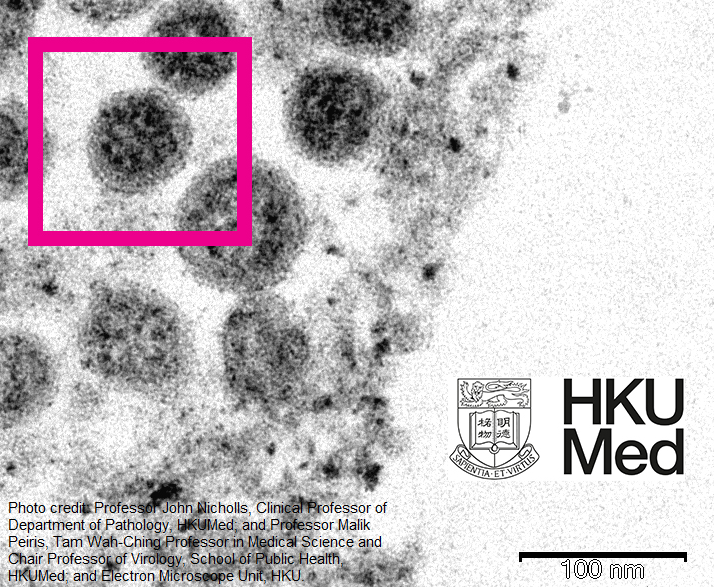
(사진 출처: 존 니콜스 교수, 병리학과 임상교수, HKUMed; 그리고 말릭 페이리스 교수, Tam Wah-Ching 의학 교수 및 바이러스학 석좌 교수, 공중보건대학, HKUMed; 및 전자현미경 유닛, HKU.)
“오미크론 변종을 걱정해야 할지 말아야 할지” 분석하기 전에, 먼저 SARS-CoV-2 Omicron 변종에 대해 알아 보겠습니다., 남아프리카에서만 등장한 9 십일월 2021, 다음 달 말까지 전 세계를 휩쓸며 돌발 감염이라는 말을 남겼다., 세 번째 복용량과 인기 검색에 대한 부스터.
고도로 돌연변이된 스파이크 단백질은 바이러스로부터 방어를 더욱 어렵게 만듭니다..
기사 시작 부분의 전자현미경 이미지는 리카싱 의과대학이 공개한 세계 최초의 '오미크론' 사진이다., 홍콩대학교 (HKUMed) 12월에 8, 2021:
바이러스 입자의 표면은 왕관 모양을 하고 있다, 이것이 스파이크 단백질이다 (S 단백질) 바이러스가 세포에 침입하는 데 사용됩니다..
바이러스는 이러한 스파이크 단백질에 의존하여 세포 표면의 수용체에 결합합니다., 세포의 세포내이입 메커니즘을 촉발하여 위험한 적에게 문을 연 다음 세포를 가두어 새로운 바이러스 입자를 복제하여 더 많은 세포를 감염시킬 수 있도록 돕습니다..
그러므로, 스파이크 단백질은 바이러스가 세포에 침입하는 핵심일 뿐만 아니라, 바이러스를 '정확하게' 식별하고 포획하도록 면역체계를 훈련시키는 백신의 표적이기도 하다.. 돌연변이 정도가 클수록, 백신으로 유도된 항체가 이를 놓치기 쉬울수록.
지난 11월 로마 명문 밤비노 게수 병원에서 발표한 '델타'와 '오미크론' 스파이크 단백질의 3차원 모델을 비교한 다음 사진부터 27, 2021, 왜 Omicron이 Delta보다 전송성이 더 높은지 이해할 수 있습니다..
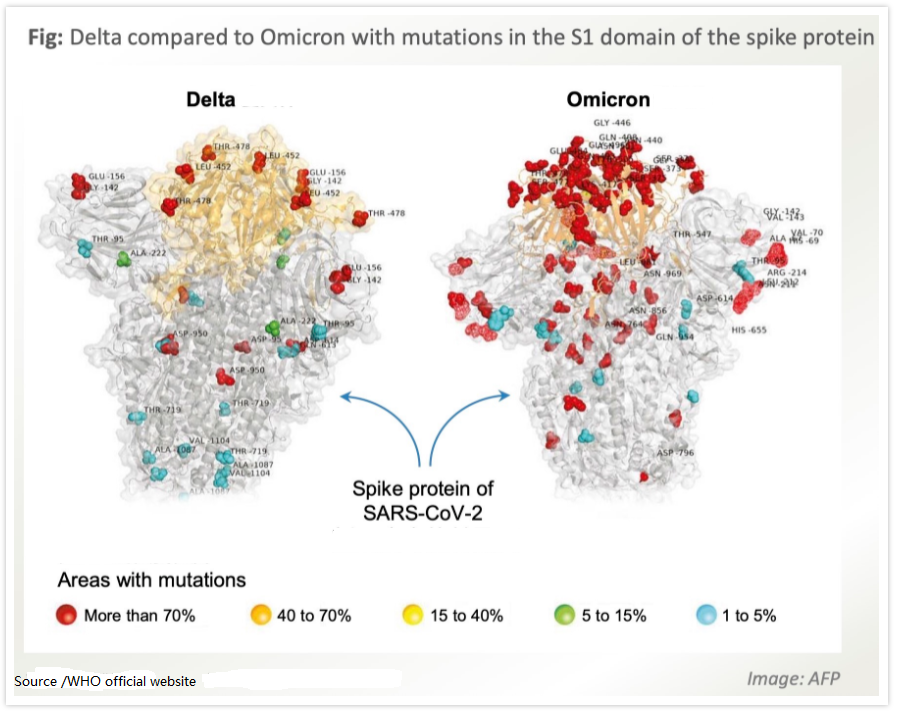
(출처/WHO 공식 홈페이지)
색깔로 표시된 위치는 원래의 바이러스주와 다른 돌연변이 부위입니다.. 분석에 따르면, 적어도 있습니다 32 "Omicron" 스파이크 단백질의 주요 돌연변이, "델타"를 훨씬 초과, 그리고 고도로 돌연변이된 (빨간색) 영역은 또한 인간 세포와 상호작용하는 위치에 집중되어 있습니다..
이런 돌연변이는 '오미크론'이 인간 세포에 침입해 번식하기 쉽게 만든다., 사람들 사이에 확산되고 기존 백신으로 인한 면역을 회피하기 위해, 획기적인 감염이나 재감염으로 이어지는 경우.
'오미크론'은 기관지에 쉽게 감염되지만 폐로 침투할 가능성은 낮다.
HKUMed가 지난 12월 공식 홈페이지에 발표한 연구 결과에 따르면 15, Omicron 변종은 다음과 같이 복제됩니다. 70 인간 기관지에서는 델타와 원래의 코로나19 변종보다 몇 배 빠르지만 인간 폐 조직에서는 상태가 좋지 않습니다..
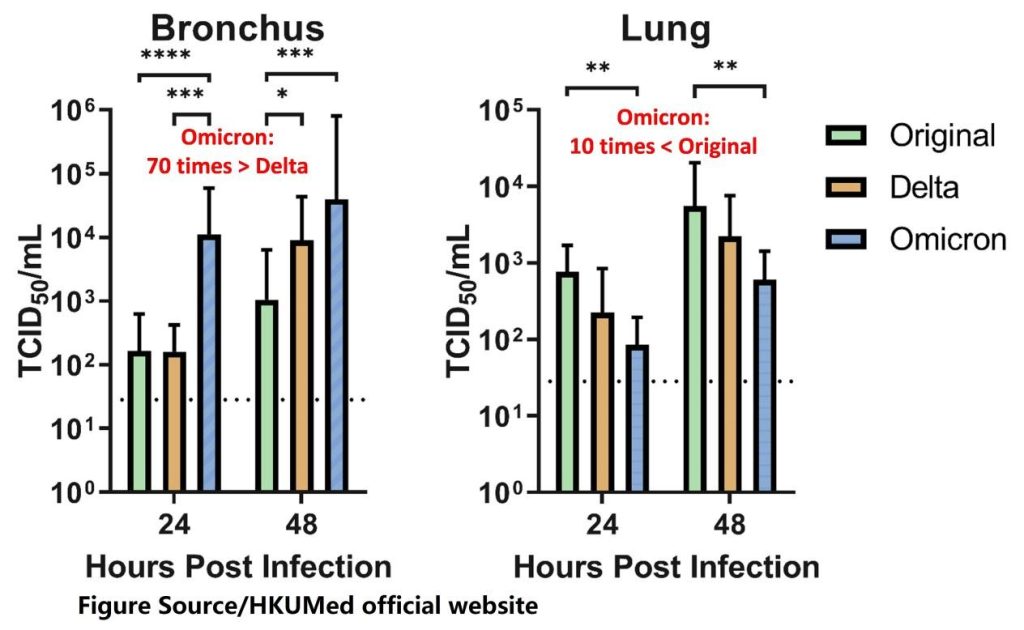
(그림 출처/HKUMed 공식 홈페이지)
이는 감염 초기 증상이 나타나는 동안 "오미크론"이 빠르게 퍼지는 이유를 설명할 수 있습니다. (목이 쉬다, 코막힘) 감기로 착각하기 쉽지만 질병의 심각도는 상대적으로 낮습니다..
하지만 '오미크론'은 심각한 질병을 일으킬 가능성이 적으니 가볍게 여기지 마세요.. 최종 결과가 우리를 기다리고 있는지 누가 알겠습니까??
더 많은 것은 무엇입니까, 아직도 우리를 동시에 쳐다보는 '델타'와 '인플루엔자'가 있다! 이를 피하는 가장 좋은 방법은 매일 면역력을 높은 수준으로 유지하려고 노력하는 것입니다..
그러니 '오미크론'에 대해 너무 걱정할 필요는 없지만, 조심해서 예방 조치를 취해야 합니다..
세포가 Omicron 변종에 감염되면 어떤 모습일까요??
HKUMed에서 제공한 다음 전자현미경 이미지를 살펴보세요..
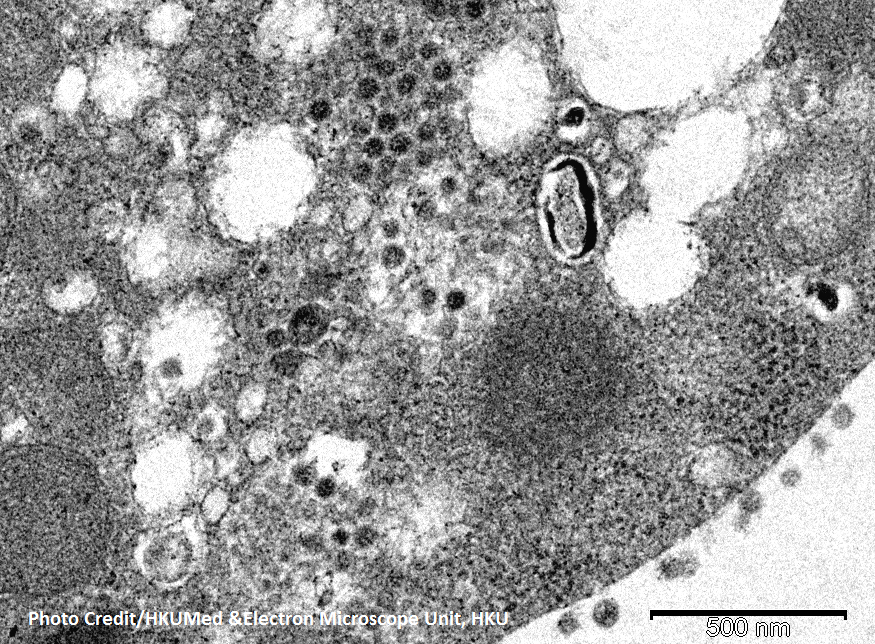
(사진 제공/HKUMed & 전자현미경 유닛, HKU)
이것은 Vero의 전자현미경 사진입니다. (원숭이 신장) 셀 24 SARS-CoV-2의 Omicron 변종에 감염된 지 몇 시간 후. 세포소포에 많은 바이러스가 복제되는 것을 볼 수 있습니다., 복제된 바이러스 입자는 제 역할을 할 준비가 되어 있는 세포 표면으로 방출됩니다..
이것은 단지 '하나의 세포'를 이용해 바이러스가 복제한 새로운 바이러스일 뿐이다.. 정말 빠르다! 다행스럽게도, 이건 그냥 체외 세포 실험일 뿐이야. 생체 내에서 발생하는 경우, 우리는 얼마나 많은 세포가 고통을 받을지 모릅니다, 그리고 이때 감염자는 무증상인 경우가 많다.; 누군가가 잘못되었다고 느끼고 그것을 방지하고 싶을 때, 너무 늦었어!
감염 후, 일부 바이러스는 세포 내부에 있고 일부는 세포 외부에 있습니다.. 면역 체계는 다양한 방식으로 바이러스를 처리합니다..
백신접종으로 유도된 항체는 오직 포획만 할 수 있습니다. (무력화하다) 세포 밖의 바이러스. 바이러스가 세포 안으로 들어가자마자 차단할 수 있다면, 상황은 비교적 간단하다; 바이러스가 세포에 감염되면, 면역 세포는 세포 내 바이러스 복제를 차단하고 바이러스 증식의 양과 속도를 줄이기 위해 인터페론을 분비해야 하며, 감염된 세포를 죽이기 위해서는 "살인 T 세포" 또는 "자연 살해 세포"도 필요합니다..
항체에 의해 잡힌 바이러스와 죽은 감염된 세포 모두 비트를 수집하기 위해 대식세포가 필요합니다.. 이 전에, 대식세포와 수지상 세포도 "도우미 T 세포"에 신호를 보내는 데 도움을 주어야 합니다., 면역 체계의 최고 사령관, 그런 다음 세포독성 T 세포와 중화 항체를 생산하도록 올바른 명령을 내립니다..
백신접종은 항체를 유도할 수 있다, 항바이러스 약물은 세포 내 바이러스 복제를 억제하고 바이러스 확산을 늦출 수 있습니다.. 하지만, 정말 바이러스를 없애려고, 완전히 동원되고 강화되려면 면역체계의 모든 요소가 필요합니다..
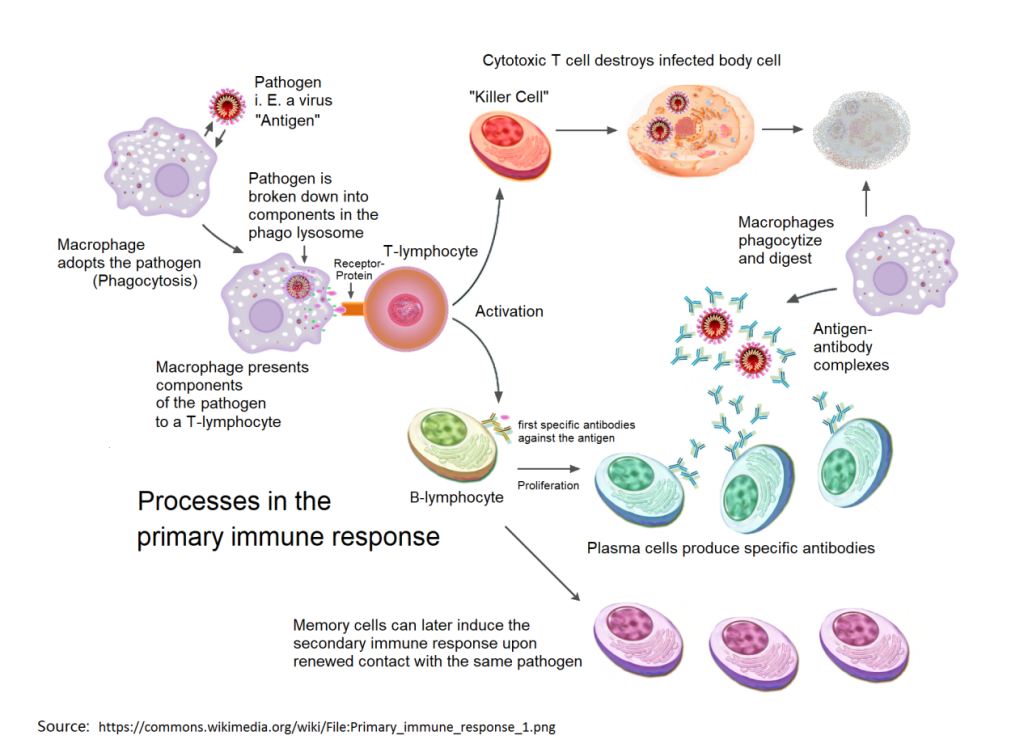
그래서, 예방접종을 받은 후, 면역세포를 종합적으로 늘리는 방법, 면역 반응 강화, 면역 기능 향상, 면역 균형을 촉진, 과도한 염증을 피하고?
1990년대 연구 이후, 영지버섯 수지상 세포의 성숙을 가속화하는 것으로 입증되었습니다., T 세포의 분화를 조절, B 세포에 의한 항체 생성을 자극합니다., 단핵구-대식세포의 분화 촉진, 자연살해세포의 활동을 강화하고, 각종 면역세포의 증식과 각종 사이토카인의 분비를 도와줍니다., 면역 체계에 대한 포괄적인 규제 효과가 있습니다.. 이러한 효과는 모두 아래 다이어그램에 요약되어 있습니다..
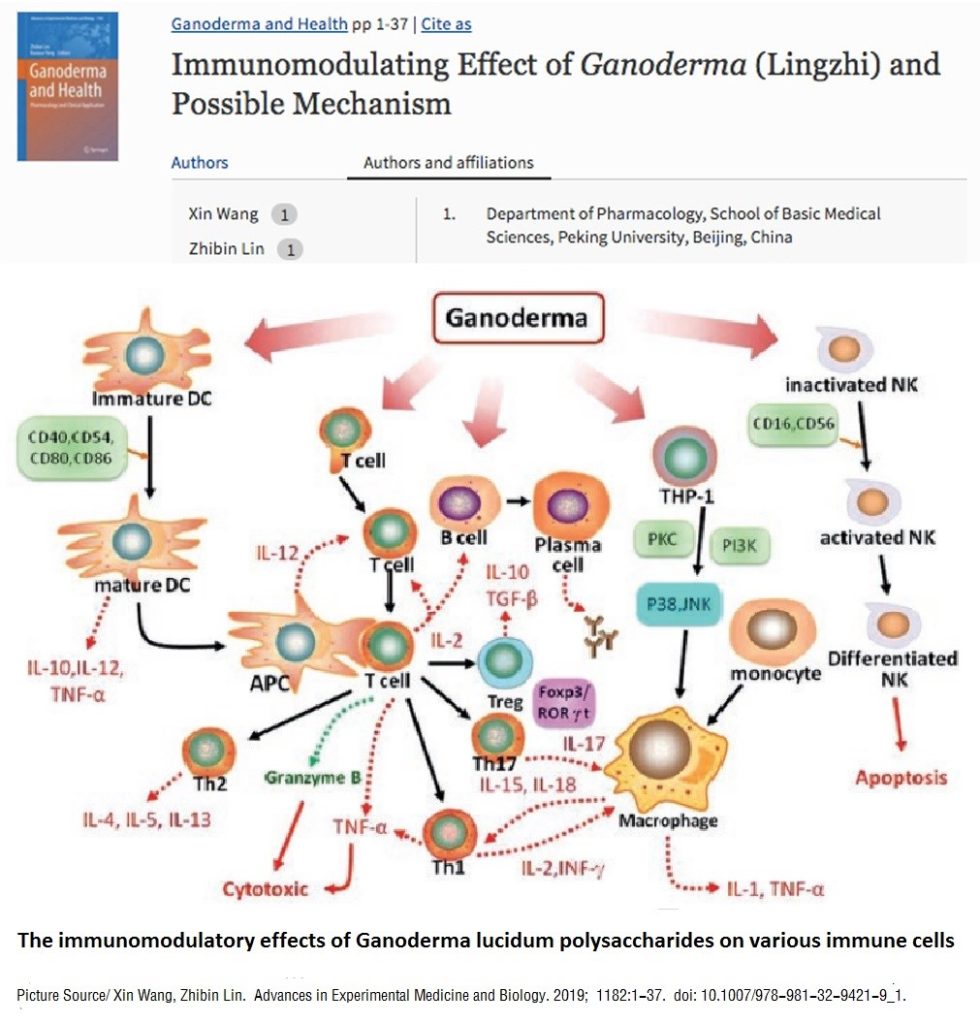
후속 조치에서는, “왜?”에 대해 좀 더 자세히 설명해 드리겠습니다.영지버섯 바이러스와 싸우는 데 필요한 면역력을 강화하는 데 도움이 될 수 있다”는 국제학술지에 다수의 논문 게재. 그 전에, 우리는 당신이 식사를 시작하길 바랍니다영지버섯 평소 면역력이 매우 중요하기 때문에. 매일 좋은 면역 체계를 유지해야만 매일의 안전을 보장할 수 있습니다..
끝
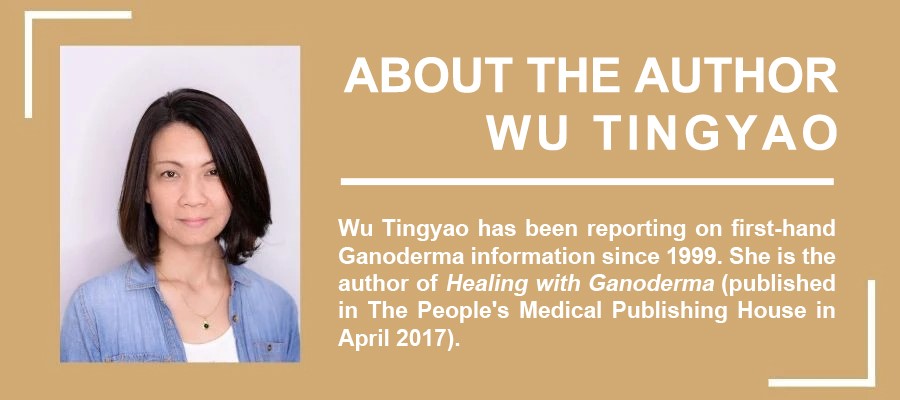
★ 이 글은 저자의 단독 승인 하에 게재되었습니다., 소유권은 GANOHERB에 속합니다..
★ 위 작품은 복제할 수 없습니다, GanoHerb의 승인 없이 발췌되거나 다른 방법으로 사용되는 경우.
★ 이용허가를 받은 저작물인 경우, 승인 범위 내에서 사용해야 하며 출처를 표시해야 합니다.: 가노허브.
★ 위 사항을 위반한 경우, GanoHerb는 관련 법적 책임을 추구합니다.
★ 이 기사의 원문은 Wu Tingyao가 중국어로 작성하고 Alfred Liu가 영어로 번역했습니다.. 번역 내용에 차이가 있는 경우 (영어) 그리고 원본 (중국인), 원래 중국어가 우선합니다. 독자들이 궁금한 점이 있으면, 원작자에게 연락주세요, 양. 우팅야오.

천년 건강문화를 전하다
모두를 위한 웰빙에 기여



